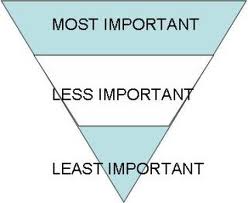If you took a journalism class in school, you know how important the inverted pyramid is. Give people the top headline first – then the details. Start with the big a-ha headline – always – to grab attention.
Yet, too many companies – especially in technology – get caught up in the weeds. They start at the bottom of the pyramid, in the details, rather than starting with the most important element – the big human need headline! Too much marketing focuses on the ‘how’ (process, methodology, technology) when it should focus on the human need first. That’s the big headline your customer cares about.
I was recently investigating a company on behalf of a client. I was asked to see what the company could do to drive new customer acquisition. In my first meeting with this technology company, the account manager started by telling me all about the profiling technology and how it works. What?! We were so far in the weeds, and we hadn’t established a fit based on need. So why would I care about how the technology works? I didn’t!
I stopped the conversation and said, “Let’s not talk about HOW the technology works. Tell me how you will grow my client’s business. How will my client be better off because of working with you?” The account manager was trained to speak about technology, not about the human need.
Ditch the technology discussion! Start with the human need. The account executive should have started with something along the lines of, “I hear, Kathy, that your client’s number one focus for growth is new customer acquisition. We can help your customer grow its ideal customer base, increase loyalty, and we can typically reduce the cost of acquisition per customer. That means profitable growth while marketing expenses decline.” Better right?
Another way to demonstrate that you can meet my human need is to tell me a story that shows me how you have helped other customers. “Kathy, company A came to us with a similar situation and they were about your size. They had plenty of the wrong customers. After working with them, the company not only increased the top line, they grew repeat sales by targeting the ideal customer. We could do that for them by analyzing their current best customers and finding more prospects just like those. We increased conversions by 15% and reduce customer acquisition costs by 30% in two months.” You can hear and feel the difference.
Another big human need here is reducing personal risk. Personal risk is as important – if not more! – as business risk when it comes to purchasing. This underlying human need for reducing risk often keeps people from challenging the status quo. This vetting was on behalf of a client, so I need to know a solution can make me look good. This company knew that; yet it never took the opportunity to actively address it. I had to ask repeatedly to extract an answer. Here’s what they should have said: “Kathy, I see this is for a client of yours, so you feel some risk. While we encourage an investment of $X, we can accelerate the program and, if after 2 weeks, we’re not getting results for your client, they don’t pay.” That’s a huge headline that addresses another big, personal human need.
And always get rid of the jargon. Instead of saying, “our breakthrough algorithms use pixels to match the threshold profile…” which is how this conversation started. All I heard was, ”blah, blah, blah!” Stop! Tell me in simple terms, such as, “Kathy, we learn the behavior of your best customers as they shop on your site. We then find potential customers on similar sites by targeting new customers who share similar characteristics to your best existing ones.”Simple is best – especially when the details can be complex.
The details of “how” you work are never the lead story, especially for a technology company. Technology is only as good as the lives it improves. So tell me why I should care. Or tell me a story of how it helped a similar-sized client meet a goal.
Save your ‘how’ for last. If I don’t care about the why and what – I sure won’t care about the how!




